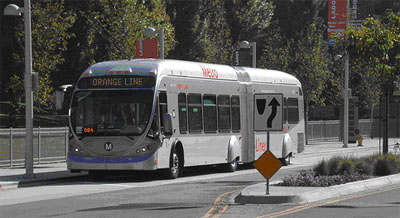LA’s BRT Orange Line improved passenger travel times by 15-25 percent over existing express bus service.
Bus Rapid Transit (BRT) is a high-quality, high-capacity bus service that travels on exclusive lanes along designated routes. Often compared with the speediness and comforts of a streetcar, BRT is not your typical bus. While Chicago is formulating plans to implement the first phase of an extensive BRT network, the Los Angeles County Metropolitan Transit Authority has been managing and operating BRT lines in the city since 2005.

Spanning over 469 square miles (166 square miles more than the geographic area of Chicago), Los Angeles faces several transit challenges: extended distances, mountainous terrain, and occasional earthquake conditions. To construct an extensive elevated or subway system similar to those in Chicago or New York would be costly, lengthy, and provide only limited service. So, instead, Los Angeles chose a combination of subway, light rail and BRT lines to provide efficient and quick transit for residents. Known as the Orange Line, LA’s BRT runs 200 low-floor articulated buses on a 14.2-mile route along a former Southern Pacific railway right-of-way. With 14 regular stops along the route, buses arrive every 6 minutes during peak hours and average speeds of 20 miles per hour (compared to regular buses that travel an average of 12 miles per hour). LA’s BRT system is a reliable and accessible service for the city’s transit passengers.
BRT can add value to any transit system and has several benefits. For one, BRT service can quickly be implemented in a region, especially compared to fixed rail service. Los Angeles took seven years to construct its Red Line subway system, but was able to add transit service with BRT in just two years. Secondly, BRT is much cheaper to build and operate than heavy rail. Compared to the $4.5 billion it took to construct LA’s 17.4-mile subway, the city spent $330 million to implement the Orange Line BRT. Finally, BRT stations have similar characteristics to train stations, and developers often invest in areas around BRT stops. Shops, housing, bike lanes, wide sidewalks, landscaping, and park-n-ride stations complement the BRT stations along the routes, helping to improve the overall community.
Chicago’s recently announced plans to implement a reliable BRT network will increase the city’s ability to move people, goods and ideas throughout the region. As the city frames this new transit service, it is important to continue to learn from best practices and experiences throughout the world.